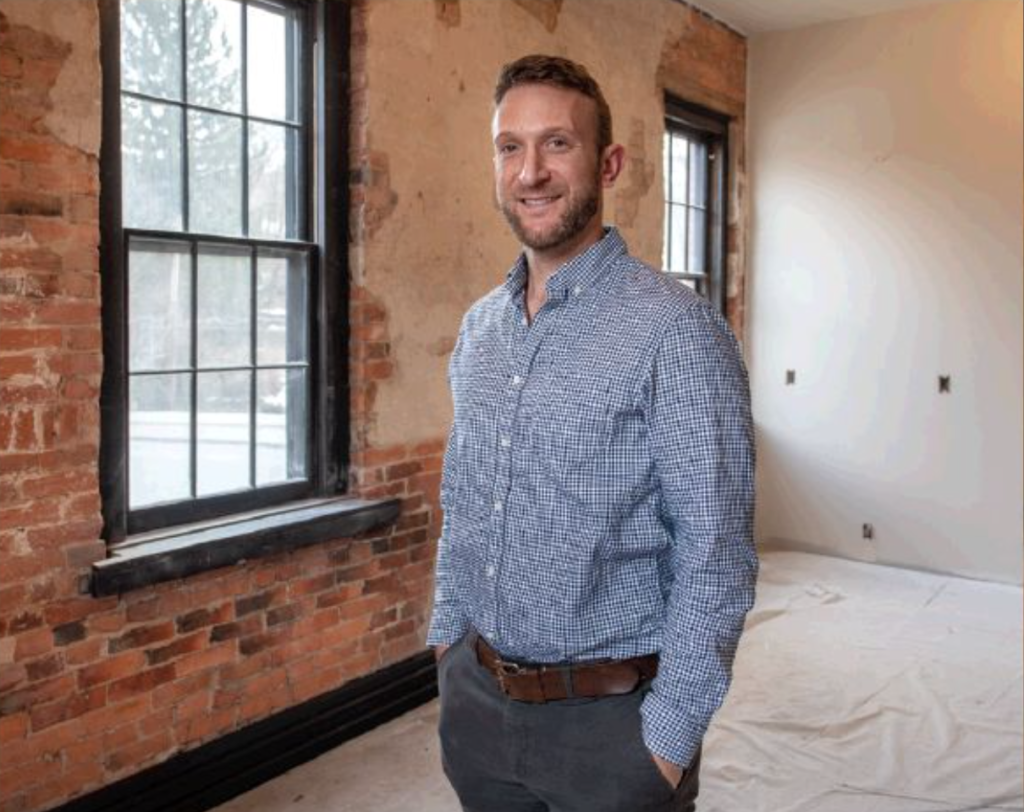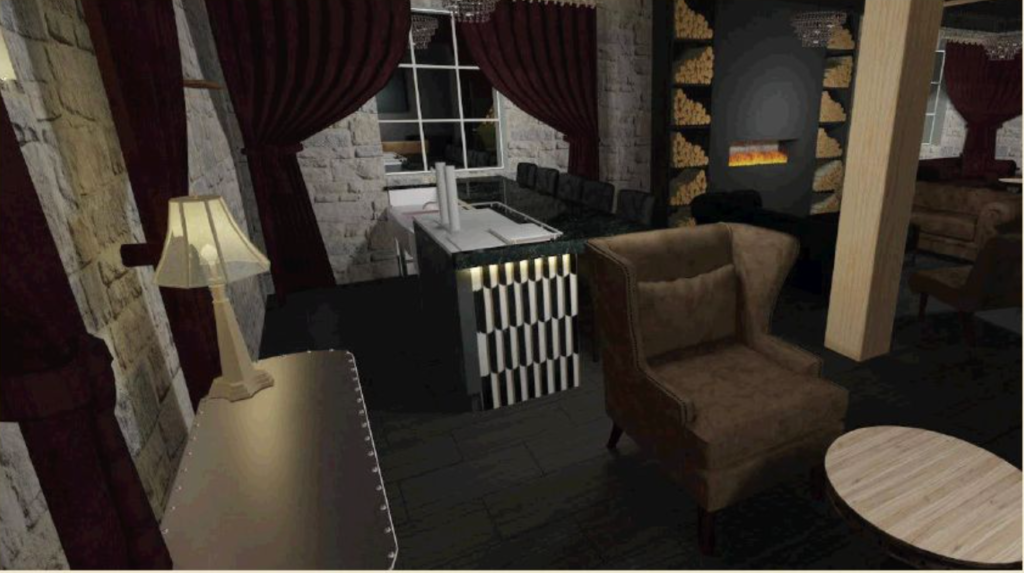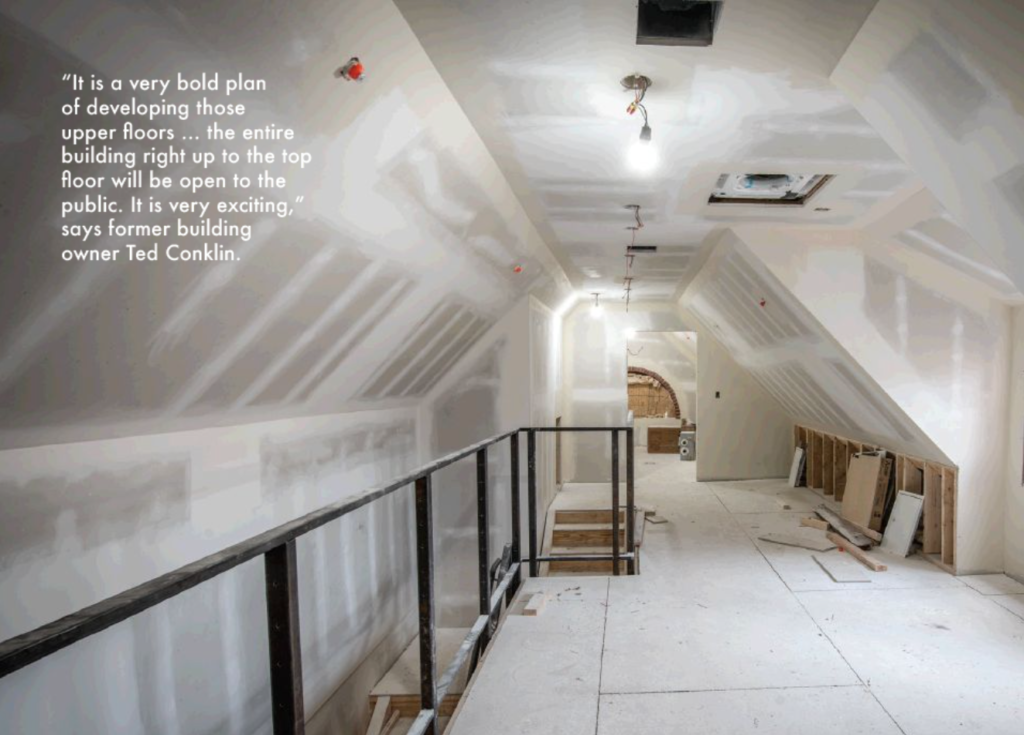This story appears in the April 2021 issue of Town&Gown.
A part of Bellefonte’s history will soon be alive and well again when the Gamble Mill opens to the public after being closed since 2015.
New owners plan to open the restaurant, bar, hotel suites, and private event space in the revitalized old mill in June.
Soon enough, people will be able to walk through that historic arched doorway to meet friends at the old bar they used to know so well. Diners will able to walk up an open stairway to sit in the dining room, enjoying locally sourced food with flavors from around the world. Those who wish to stay in town with style can take in its history in boutique inn and suites on the formerly underutilized upper floors of the old mill. A retail space will give shoppers another local connection.
Brothers Christopher and Jonathan Virgilio bought the property in 2019, and their vision is bringing the old mill back to life. With restaurant owner and Chef Michael Marx taking over the kitchen and dining area, it looks like memories will soon be made again at the Gamble Mill.
Storied history
The Gamble Mill’s history dates back to before Bellefonte was even a town. According to Local Historia, William Lamb built the original water-powered grist mill in 1786. In 1795, Bellefonte founders bought up much of Lamb’s property to establish the borough. From 1800 to 1809, James Smith, the son-in-law of founder Colonel James Dunlop, took ownership of the mill.
On May 25, 1892, a large fire that started in a grain warehouse near the mill caused extensive damage to original building. The footprint and south end of the mill remained, but the building that stands today is essentially an 1893 Victorian structure.
Through the years, there were many prominent owners of the Gamble Mill, including George M. Gamble (1901-1923), for whom it was named.
By the middle of the 20th century, the mill was no longer used for grain production. In 1975, Ted Conklin bought the mill from a beer distributor. His efforts saved the mill from being demolished and succeeded in placing it on the National Register of Historic Places. Conklin’s vision turned the mill into a community asset, establishing it as a favorite Bellefonte dining place.
Conklin is amazed at the effort the Virgilio brothers made to preserve the building’s history and realize its potential.
“The level of commitment that Jonathan and his brother are making there is just amazing. I thought my role of importance with the building was developing the restaurant, but my understanding now is that the most important thing I ever did with the building was just to secure the building until the right person ever came along to do it right, or in this case, the right two people,” says Conklin.

Brothers’ vision
Looking back at all their painstaking effort since he and his brother decided to purchase the building in December 2019, Jonathan Virgilio can’t help but be a little nervous to be getting close to opening. While the two brothers have experience rehabbing old buildings, the Gamble Mill has been perhaps a bigger gamble than they first expected.
“I don’t know if we really thought through all the work it was actually going to take,” says Jonathan, with a laugh and a smile that always seems to be on his face. “I think that is a good thing we didn’t and we were so excited about it. My brother and I joke [that] if were to do it again, we don’t know if we would, but we’re confident it will be worth it come June.”
As he spoke about all the work that went into the project, his knowing smile seemed to share the expectations a whole community has for the property.
“It is exciting but nerve-racking, because the construction phase is coming to an end, but then, all of a sudden there is the responsibility of running a business. My brother and I want to do it right. There is a lot of history for a lot people in this building, and so we want to make sure we meet that history,” says Jonathan. “We know what it takes and that is humbling in itself, so hopefully we are able to do it right. It has been very stressful, but we also see the reward that is it is going to bring for the whole community. I think Bellefonte in general is on the cusp of a surge to really be a phenomenal, outstanding small town.”
The renovation meant clearing out more than 40 trash bins of old junk left in the building through the years. It meant working to preserve the historic nature of the building while giving it all the modern amenities one comes to expect. It also meant dealing with the impact of a pandemic just as the project was starting.
The entrance of the building is going to look new and old at the same time. Walking through the open archway, stairways have been moved back to the original location.
“We really wanted that to be a grand entrance and really showcase what the history of the mill actually was, which was for grain, and also remembering the roots and purpose of it,” Jonathan says. “It was a very industrial building, so different touches we did, such as the black windows, the exposed duct work, the finishes, are more industrial feeling. … I think the history of the building, we crafted everything to revolve around that, from everything for the design, to even our business plan.
“We utilized all the square feet to help sustain our business plan and help diversify the different types of business, and also with that model to make it a destination where people who are coming from out of town will come and then visit the rest of the town.”
Making use of the upper three floors of the mill as hotel rooms was something that Conklin always dreamed about.
“It is a very bold plan of developing those upper floors. It is something that a lot of different people, including myself, were looking at figuring a business plan to really open that building up, and they have done that, and the entire building right up to the top floor will be open to the public. It is very exciting,” says Conklin.
The Virgilio brothers and two friends, Cody Jones and Megan Marcaurelle-Jones, will be revitalizing the old pub area tucked away on the ground floor of the mill. The Republic at the Gamble Mill will feature simple craft cocktails and local beer.
“We are looking to do around eight signature cocktails, kind of something new to this area. Classic cocktails that you might see in an urban setting,” says Jonathan. The bar will also include five to seven beers on tap, along with an assortment of wines. Old materials are being repurposed into furniture.
“More or less we are trying to complement the restaurant … catering to the before- or after-dinner crowd,” he says. “It will cater towards people who want to experience the atmosphere of an old building.”
Down the hall, below the restaurant, will be The Speakeasy at Gamble Mill, an event space that can be used for small parties, work meetings, or other gatherings. The space looks to be a comfortable, fun place for a party, with thick curtains complementing the historic brick of the mill and giving the space a roaring ’20s feel.
“It will be versatile; it could be tables and chairs, or furniture, and it will seat up to 50 people. We really hope to provide something different in Bellefonte,” Jonathan says.

Also on the ground floor will be an accessible hotel room and the retail space. A local store owner (not named as of press time) plans to move in to the location.
Upstairs are another seven short-term boutique suites, for an overall total of two 1-bedroom, four 2-bedroom, and two 3-bedroom suites. They are meant to complement the waterfront hotel planned nearby by other developers. The old, exposed beams and brick keep the building’s past alive, while modern amenities will make guests comfortable.
Each room will be named after one of the former building owners. Looking out the windows from the fifth floor of the mill in one of the large hotel suites, guests might just feel like one of those old mill barons of yesteryear, looking down at Spring Creek and the Victorian town below. Jonathan Virgilio hopes it all inspires people to explore the history of the building and Bellefonte, just as he has.
“I hope they feel invited and warm,” he says. “I hope there is still a piece that they remember back from when the mill was only a restaurant and bar, and I hope that they are also inspired to where they want to explore or stay here. There are three floors that have never been utilized to the public, so I think that is something that I think people will be curious about and want to come back to take in.”

By the Creekside
Taking over the signature restaurant on the first floor of the mill will be a familiar face for many in Centre County. For the past six years, Chef Michael Marx has been feeding those looking for flavors from around the globe from his World’s Fare food truck and catering business.
The historic nature of the old mill drew Marx in to opening Creekside at Gamble Mill in the dining space at the mill. This is not his first go-round at opening a new restaurant in an old building. In fact, Marx says it is in his blood.
With a family history of rehabbing old historic properties into popular hotels and restaurants in Ohio and San Diego, Marx opened up his first solo restaurant after he and his wife renovated the grand lobby of the historic 1917 McHenry Theater in Baltimore. Later, he opened a Texas barbeque joint in South Baltimore, before gutting The B&O Railroad Locust Point Grain Terminal, built in 1923, for an upscale Mexican restaurant.
While he has been busy overseeing kitchen and dining room renovations, Marx is also planning his cuisine at Creekside, which will feature an ever-changing menu with local flavors.
“Everything I have done has been some form of historical building. … It is in my blood; I would rather see brick and beam than I would steel and glass. … I feel at home here, because I am comfortable. So if I am comfortable, I’ve got to believe that I can make you comfortable,” says Marx.

As a chef, Marx embraces flavors from all over the world, while also embracing “mom’s comfort food.”
“There will be some things on the menu that people have never heard of, but their will always be that safety net, that comfort food for somebody who just wants a good, hearty meal,” says Marx. “Sure, there will be a lot of ethnic tint to the menu, but at the same time, one of the dishes I am doing is chicken and waffles. …I am doing a dish that I have done so many times I could do it with my eyes closed, steak au poivre. It is a really classic dish, but if you are a meat-eater, it is seared tenderloin medallions, potatoes, and green beans. There is brandy in the sauce; that is the big woo-hoo, but to me that is still comfort food.”
Through his six years of sharing his flavors out of the food truck, Marx has built a connection with local farmers and producers that he believes will carry over even stronger at Creekside. Also of importance to Marx is offering a menu that the average diner can afford.
“One focal point is to be price-conscious,” he says. “Yeah, I am going to be working with local farms and doing a lot of local stuff, and that is a lot more expensive … but having two kids who are mature eaters, it is absolutely essential to me that parents who have kids can come in and eat and it not be a special occasion. So I think that what people who don’t know me can expect is not only that they will be able to afford to eat my food, but they can feel adventurous or totally safe, and they will leave happy, because they are going to find something they are comfortable eating.”
With COVID-19 restrictions easing, diners will be able to sit at the old, long bar and at tables in the large room. An outdoor patio is planned by the “creekside” of the old raceway that powered the mill in its heyday.
Marx has been working with local wood and metal workers to provide some of the furnishings for the space. While he is not from this area, he appreciates its long history and now he is glad to be a part of Bellefonte’s exciting future.
“I think that I am coming on this early cusp of a real rejuvenation of Bellefonte; maybe 15 years ago my food might have been too far out of the mainstream. But, right now, it is right down the pipeline,” says Marx. “The idea is that this restaurant will be accessible, and will be alive again and as this waterfront grows, it is going to be stupendous.”
***
Vincent Corso is a staff writer for Town&Gown and The Centre County Gazette.






